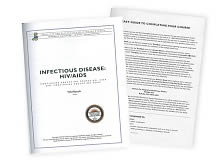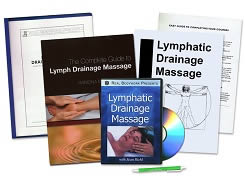Updated November 15, 2019
Considering the number of individuals living with the Human Immunodeficiency Virus (HIV) and Acquired Immunodeficiency Syndrome (AIDS), it is essential for massage therapists to understand the prevalence, transmission and support needed for this disease. Various state licensing agencies underscore its importance by requiring continuing education in HIV/AIDS.
Prevalence
According to the World Health Organization (WHO), in 2018 approximately 37.9 million people worldwide were living with HIV/AIDS. As the most publicized infectious disease in the western world, there is substantial fear among alternative healthcare practitioners about being in close contact with an infected individual.
Transmission
Since HIV is only acquired from blood-to-blood contact, safe and hygienic practices eliminate risk from massaging an HIV client. Transmitted through direct blood contact with an infected person; the most common method of transmission is sexual contact. Other modes of transmission include needle sharing, blood transfusions and the birth of a child to an infected mother. HIV is not spread through casual contact.
Support
Since the pathology involving HIV/AIDS advances when the immune system is compromised, any modality boosting immune function inhibits disease progression. Research demonstrates that bodywork is an ideal method for supporting an HIV-infected person’s immune system. Therefore, massage therapists working with this population offer extremely valuable and therapeutic support. When operating within safe and hygienic parameters, a bodyworker’s compassion and care can be the single most important component of a person with HIV’s treatment and recovery plan.
Stigma
The stigma surrounding AIDS can impart many negative effects on the mind and body. Unfortunately, one of the first reactions of friends and family to a diagnosis of HIV is a reluctance to touch the person. People living with this disease are typically viewed by some people as ‘untouchable’ members of society, furthering feelings of isolation and depression. Due to this stigma, the hands-on intimacy of massage therapy provides a great psychological benefit to a client with HIV.
A study published in the International Journal of Neuroscience evaluated HIV-positive adolescents and randomly assigned them to receive massage therapy or progressive muscle relaxation twice per week for 12 weeks. To determine treatment effects, participants were assessed for depression, anxiety and immune changes before and after the treatment period. Adolescents who received massage therapy versus those who experienced relaxation therapy reported feeling less anxious, less depressed and demonstrated enhanced immune function as determined by blood immune markers.
Immunity
Strengthening a person’s immune system gives them an advantage when fighting disease, including HIV/AIDS. A recent study of massage’s impact on HIV-positive children demonstrated this fact. Researchers observed a marked increase in natural killer cells in HIV-positive children receiving massage therapy than those who did not receive massage. Natural killer cells are unique in that they attack only cells infected by a microbe. The children who did not receive massage had a steady decrease of these important immune cells, while those receiving treatment either remained stable or had an increase in natural killer cells.
Why Massage Works for HIV
Massage boosts immune system function by:
- Reducing anxiety and stress
- Increasing white blood cell counts
- Decreasing levels of the stress hormone, cortisol
- Activating natural killer cells
Specific to HIV/AIDS symptoms, massage can also decrease pain by relieving:
- Muscle spasms
- Cramps
- General body tension
- Edema
- Inflammation
Additionally, by increasing blood flow, massage assists in the removal of toxins while increasing oxygen and nutrients to areas with symptoms.
More Massage Goals for HIV
Various massage modalities can be incorporated into a massage therapy HIV program. Specific indication of techniques could unfairly exclude one that is valuable, so consider any technique sharing the following goals:
- Facilitating the removal of excess phlegm to relieve respiratory congestion
- Increasing blood and lymph flow to assist the liver function in toxin removal and to encourage blood cell regeneration
- Preventing or reducing muscular atrophy typical of immobilization/inactivity through improving muscle tone
- Mechanically breaking down adhesions characteristic of post-surgical scar tissue
Tips for Working with HIV Clients
Some general guidelines for massage therapists to follow when working with HIV/AIDS patients include:
- Being educated about HIV’s etiology and pathology
- Performing a thorough client history
- Surveying the client to ascertain there are no cuts, open wounds or bleeding
- Surveying your hands to ascertain there are no cuts, open wounds or bleeding
- Keeping your nails short so they don’t accidentally scratch the client
- Washing your hands thoroughly with warm water and soap before and after massage
- Rescheduling with an HIV client if you are sick, since their immune system is extra vulnerable to catching your own illness
- Refraining from direct pressure on any open lesion, inflamed area or on a client with a circulatory system infection. Instead, choose point specific massage and avoid the affected area. Energy work can be used in cases of bacterial infection and fever.
- Monitoring your client for dizziness, nausea or lightheadedness, as they may be experiencing a large toxin release. In this case, gentler work, shorter sessions and increasing hydration will serve the client.
Understanding that the safe and hygienic practice of massage therapy poses virtually no risk of HIV transmission will encourage the HIV-positive population to take advantage of the beneficial services bodywork offers. In addition to educating yourself on this disease, adhering to the nine tips previously mentioned will enable massage therapists to be a valuable addition to an HIV-positive client’s medical team. Since bodyworkers can positively influence both physical and psychological health, their unique personal touch can easily be the most therapeutic portion of HIV/AIDS treatment.














2 Responses to Massage Therapy for HIV/AIDS